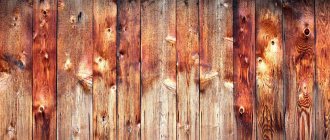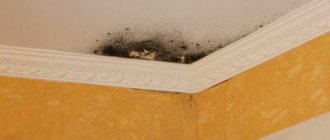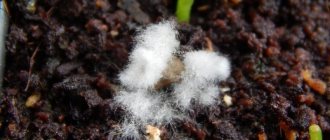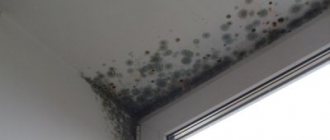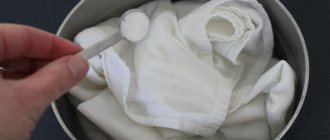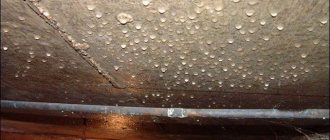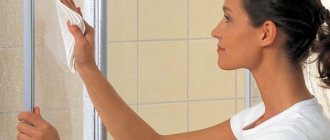We were flooded and black mold appeared under the linoleum, what should we do? This question was sent to us in feedback, and the answer filled an entire article.
We will analyze the questions of how to dry the floor under linoleum and laminate after flooding; Is it possible to remove traces of fungus on a concrete floor without major repairs? We will also consider the situation with wooden floor boards, whether they can be treated without replacement.
Small spoiler:
- If the laminate is swollen, throw it away; it will not return to its shape.
- If you have linoleum with a jute or foam base, you will also have to throw it away, alas.
Try our methods and share yours in the comments.
How to dry the floor under linoleum after flooding
Procedure:
- Remove the covering - linoleum or laminate.
- Remove the backing, if present.
- Ensure positive room temperature.
- Install powerful fans to circulate air.
- Install mobile dehumidifiers if possible.
These are independent measures, you can try similar services in the video that will dry any floor under laminate, parquet and linoleum.
If you were flooded by your upstairs neighbors and because of them mold appeared, you can read the story of How Alena was flooded by her neighbors and she compensated for the damage through the court in Tinkoff magazine.
There are many materials on YouTube with independent methods, then we will analyze the problem of fungus.
Natural
The material, made exclusively from natural ingredients, eliminates the risk of allergic reactions and is absolutely environmentally friendly. It is made on the basis of linen or jute fabric. The composition includes 30% linseed oil and up to 30% non-biological binders. In the production of such oilcloth products the following are used:
- wax;
- wood powder;
- linseed oil;
- dyes;
- sap.
This type of coating has a long service life and will last for almost 30 years. The natural fabric does not fade in the sun and has antibacterial properties and is installed in medical institutions. It is presented on the market in the form of rolls or tiles, which are used for arranging floors with complex patterns. Designers and lovers of eco-interiors love to use it in country house projects. It is easy to install, does not slip and can be restored. Not used at sub-zero temperatures and for rooms with high humidity, such as a toilet, bathroom.
How to get rid of mold on linoleum using folk remedies
Every person has to deal with mold. And in addition to black mold, white rot may also appear in the house, which can quickly ruin a wooden floor .
At the same time, it will also smell very strongly. People began to fight fungi a long time ago; a lot of methods have accumulated; we have identified the most effective ones. You can cope on your own using only improvised means if the lesion is insignificant. When there are huge stains, it will be difficult to completely destroy these microorganisms, and the resulting mold smell is also unlikely to be removed.
Copper sulfate
Copper sulfate gives a good effect. Dissolve it in a ratio of 0.1 kg of powder per bucket of water. For heavily grown fungus, it is sometimes recommended to increase the dose of powder by 2-4 times. Some also add vinegar (0.2 l) or a chlorine-containing preparation.
When working with this product, you should take precautions - protective gloves, goggles, a respirator and thick clothing.
Lemon acid
Fungal spores react negatively to acids. Therefore, citric acid will come in handy here. If the mold outbreak is not large, it is enough to dilute 5 tbsp. in 1 liter of water and treat the affected surface with the solution.
Chlorine and similar products
Preparations containing chlorine compounds help to effectively get rid of not only the mold itself, but also destroy its spores along with the smell of rot. You will need 1 liter of product per bucket of water (regular Whiteness bleach will also work).
Work should be done using personal protective equipment in a well-ventilated area.
Borax
Many properties are attributed to this product - fungicide, herbicide, insecticide. For mold, borax is a strong poison that inhibits its development . It is necessary to dilute 4 cups of the product in a bucket of water and treat the surface several times.
Ultimately, borax will not only destroy the entire fungal colony, but also create a protective film on the floor . Therefore, it is not recommended to wash off the solution from the surface .
How to remove and destroy
There are a lot of means to combat mold. Some are more effective, some are less...
So, having chosen a mold control tactic, the following steps are taken:
- Existing mold must be removed. To do this, you can use soapy water and sandpaper.
- Treat the surface with an antifungal agent.
- Inspect all items, and if mold is found, clean them too. If you can’t clean it (the mold has settled deeply and reliably), then it’s better to throw the thing away.
- The main weapon that will work for the future “future without mold” is to establish good ventilation; you need to organize a constant flow of fresh air.
- Reduce humidity in the basement.
Professional products
The chemical industry has also produced a large number of different preparations to eliminate the smell of rot and remove fungus. But they are often very expensive due to complex components and marketing hype.
- "Boramon" is great for treating any surface.
- “Mellerud” almost instantly kills the fungus and its spores, while the drug easily penetrates the porous structure of the surface being treated.
- "SZAVO" is suitable for combating any types of fungi. Conducts not only successful disinfection, but also has protective properties. Does not require preliminary surface preparation.
You can continue to list industrial products, but different regions have different assortments, and you are unlikely to order from the Internet.
Let us remind you that the instructions given on the packaging must be followed (with all precautions).
Perhaps you should contact a special service that deals with the sanitation of premises. They have serious equipment, for example:
- Microwave, which allows you to quickly dry contaminated surfaces (using ultrahigh frequencies)
- Special vacuum cleaners for water.
- Mobile dehumidifiers.
Cleaning companies use innovative methods and use instant disinfectants to quickly remove lesions. So serious work should be entrusted to specialists . It is acceptable if the company is well-known and has guarantees.
Options and designs of concrete floors
Concrete floors offer many design, color and texture options. Click on the video below to get advice from Bob Harris about the design styles available for concrete floors, including details on which styles are most suitable for different environments.
Stained Glass Floors - Ideas for Stains on Concrete
Time: 01:54
Bob Harris will introduce you to the countless ways to decorate concrete floors with chemical stains and stains. Paints and stains can be applied to new or old, plain or colored concrete in both residential and commercial settings. They are popular in kitchens, family rooms, retail stores, restaurants, sports stadiums and even garages and basements. With both stains and dyes, the color becomes a permanent part of the concrete and does not wear off or require reapplication.
For more information, see: Concrete Staining Concrete Dyes Expand your concrete paint color palette
Images used in the video are courtesy of Colormaker Floors, Progressive Concrete Coatings, Kemiko Contemporary Floor Finishes and Bomanite.
Staining concrete provides design versatility
Time: 02:29
Harris talks about his tools and techniques for creating special effects with stains and paints, as well as different ways to personalize a floor. Because stains highlight the natural characteristics of concrete, they give it an organic appearance with a rich patina. Warm, varied color effects pair particularly well with Old World or Tuscan-style decor.
For more information, read What special effects are possible when using stains on concrete?
Images in this video courtesy of Westcoat, Flying Turtle Cast Concrete, Colormaker Floors, Kemikoating Surfaces and Modello Designs.
Limitations of acid stains in concrete
Time: 02:58
Many people love the natural color variations created by acid-based chemical stains, but they have some limitations, such as a limited palette of earth tones and unpredictable staining effects. Harris discusses how to overcome some of these limitations by combining chemical stains with dyes or using water-based dyes. Using concrete paints or water-based stains allows you to use a wider range of colors. Paints can also be used to correct problem areas that have not been left with chemical stains.
For more information see: Water Based Penetrating Stains
Images in this video courtesy of Concretizen & LM Scofield.
How to remove mold on planks in a wooden floor
In private houses and a number of apartments, preference is given to wooden floors - the natural material brings special warmth to the home. But it is also most susceptible to fungal infection due to its structure. If the spores have penetrated deep into the material and begun their destructive effect, it is more reasonable to replace the damaged floorboards with new ones .
For minor lesions on a wooden floor, you can try to get rid of the problem with a series of sequential actions.
- To begin with, each board is thoroughly washed with soapy water (it is better to use laundry soap). In this case, you should use a hard sponge.
- Now you should go through with a spatula, cleaning off the top layer affected by the fungus.
- The next step is drying the wood . A fan heater or an industrial hair dryer (or, in extreme cases, a household hair dryer) are suitable here.
- When the floor is completely dry, you can see gray marks - the remains of mold deposits. These stains must be cleaned with sandpaper .
- This is followed by treating the floors with the selected antiseptic.
- Now you can go over the stripping areas again with abrasive sandpaper, but with a small grain size, to polish the surface.
- Restored areas on the floor should be covered with the varnish that was used for this (or use aqualak).
When choosing chlorine-containing preparations, the degree of concentration should be taken into account so as not to spoil the wood.
Do not forget that fungus on floorboards can be affected not so much by the internal climate of the room as by the design features located under the wooden floor. And then you will still have to decide how to get rid of mold under the floor.
Ideally, a wooden floor structure should look like the one shown in the figure below.
Even good ventilation does not always prevent the appearance of fungus under a wooden floor , because moisture systematically penetrates there during cleaning or from below (from the basement). Wood rot usually forms under the boards and develops very quickly. In this case, you cannot do without repairing the floor.
Rot can only be removed radically - by destroying with fire everything that the spores have touched:
- You will have to tear down the entire floor and remove structural elements (joists, fiberboard, chipboard, insulation, vapor-waterproofing).
- The base plate will have to be burned with a torch, then dried, treated with an antiseptic or a deep penetration primer.
- It is recommended to make a fresh screed and replace all layers of insulation.
With the right approach to the matter, you won’t have to rack your brains; for clarity, it’s worth watching the video.
Fungus on concrete floor
Mold penetrates into concrete more slowly (due to its alkaline properties) than into wood, but it will be more difficult to remove the unpleasant black coating from such a base - after all, you will have to clean it off until a clean layer appears . To do this, it is recommended to use a grinder with a diamond cup, which, unfortunately, produces a lot of dust (you will have to work with maximum protection and a construction vacuum cleaner turned on).
Then the concrete floor is treated with an antiseptic . It is best to use a professional instant-action product that fights spores and immediately creates a special protective film on the surface (a fairly effective product is “SZAVO”).
After this, some craftsmen recommend applying a sheet of roofing material and making a new screed on it. It is better to throw away spoiled linoleum.
If you have ever had a problem with mold, please share in the comments. Maybe your story will help other readers .
Conclusion
Mold appears due to excess humidity, poor ventilation, and freezing of parts of the house.
- You need to start fighting the fungus when the first signs appear: odor, high humidity, plaque.
- You need to remove the layer of mold from wood or concrete using a tool (for small areas you can use a chemical), and then dry the surface.
- The remainder must be treated with one of the antiseptics, following the instructions.
- For prevention, it is necessary to exclude the formation of moisture and ensure ventilation.
By following the rules, you can get rid of mold quickly and effectively. If the causes are eliminated and preventive measures are taken, there will no longer be a need to fight the fungus.
Prevention
Mold can appear in an apartment at any time, and only prevention will prevent this invasion . Therefore, floor coverings should be periodically treated with antiseptic agents - both professional and folk ones can be used. At the same time, trying to treat not only the floor, but also the space under the baseboards, as well as the walls.
But, first of all, you should create a suitable microclimate in the house (apartment) in order to reduce the chances of the pest appearing to a minimum. After all, everyone knows perfectly well why signs of rot appear.
- The premises must be well heated so that there is no dampness in the rooms.
- We must not forget about regular ventilation - spores prefer musty rooms.
- Particular attention should be paid to floors in bathrooms and toilets, where condensation is a common occurrence.
- It is better to remove wooden skirting boards and replace them with plastic ones with rubber seals.
You shouldn’t wait for an emergency situation - you should start caring about the durability of the floor covering from the moment it is laid at the renovation stage, having complied with all building codes (see instructions from the manufacturers) and take care of normal hydro- and thermal insulation. Then one day you won’t have to frantically search for the source of the smell of rot.
Preventative work
The basic rule is to eliminate structural defects that cause leaks, cracks, hypothermia, and insufficient ventilation.
Additional tips:
- Leave space between the furniture and the wall.
- Ventilate regularly.
- Avoid the formation of dampness.
- Install additional heaters in problem areas.
- Provide sun access to the room.
- Dry things outside or on a special heater.
- Open doors in rooms.
- You can install fans with a humidity sensor.
A fungus growing in an apartment requires quick elimination. Taking preventative measures will help avoid re-cleaning problems.
Harm from mold
Even an invisible little speck of fungal spore lurking in a secluded corner is a slow-acting weapon. Mold multiplies very quickly , and its spores fly in the air that a person breathes. Enough to get into the nasopharynx, the fungus penetrates deeper and deeper into the body, provoking various diseases. Even physical contact is dangerous for humans - it causes fungal skin diseases .
Once it begins to multiply on the floor or under it, the moldy stain quickly grows and moves to other surfaces and penetrates cabinets. What causes things to spoil - clothes, shoes, books, even food. Slowly but surely, the fungus destroys structures in the house, which is why it is so important to remove this rot in time.
Previous
Mold and mold fungi Bread with mold in a dream: what is this for?
Next
Mold and mold fungiHow to remove the unpleasant smell of mold in the washing machine
Specifics of the appearance of fungus under the coating
During repairs, after removing a covering that is already outdated, they find fungus under the linoleum. It should be removed and preventative measures taken to protect the surface from re-spread.
Attention! Mold
, fungus has a detrimental effect on the building and human health. They cause dangerous, sometimes fatal diseases.
Linoleum
More often than other decorative floor coverings, it is susceptible to the formation of mold and fungi.
Especially if wood flooring is used as a base. Fiberboards and chipboards are considered a breeding ground for mold. Due to this, when laying material on top of them, the risk of mold increases many times over.
It must be stated that the air that surrounds us always contains a certain number of microorganism spores. They are not dangerous, but when certain conditions occur, they move from the inactive phase to the active phase and multiply.
Such conditions include a lack of light, oxygen, increased air humidity, and low ambient temperature (3-18 degrees). As a result, the fungal population grows and soon occupies the entire area under the coating.
What to do with the walls
A correct assessment of the situation will help save both time and money. In those places where there is the most mold, it is advisable to lift at least a piece of wallpaper to assess the condition of the surface underneath. If mold has affected the plaster, it will become loose, damp and dark.
In this case, it is useless to clean the wallpaper: the fungus has penetrated too deeply into the wall, and after a while the problem will repeat again. If mold only covers the wallpaper, you can try to clean it. The methods depend on the type of wall covering.
You may also be interested in: How to remove a handle from a leather sofa
Acrylic wallpaper, washable or non-woven
All these materials easily tolerate moderate amounts of moisture and are quite resistant to abrasion
You can clean them with any anti-mold product, but this must be done with caution. The only prohibition is high temperatures; heat exposure can damage the coating.
Another useful article: How to clean brass at home
Paper wallpaper
Paper wallpaper is a budget option, but quite fragile. If they are severely damaged, it is easier to get rid of them than to clean them. If mold has penetrated deep into the material, unsightly dark stains may remain. Cleaning requires patience, a hair dryer and a soft brush. Only the dry method is suitable: moisture will ruin the wallpaper.
The walls need to be dried with a hair dryer or even ironed with a hot iron, and after the paper has dried, remove the fungus with a brush. If the coating has come away from the wall, the plaster needs careful treatment, after which the wallpaper is carefully glued. When the glue dries, you need to iron them again.
Mold is not always eliminated by cleaning. A large percentage of damage to brick and plaster requires serious intervention: you will have to call the SES.
Thanks to thermal imagers, specialists will detect all lesions. They will fight mold not only by mechanical cleaning; they will also have at their disposal gas treatment, hot or cold fog installations, and high-quality safe antiseptics.
Nature of smell
Quite often, new linoleum emits an unpleasant chemical odor. In order to avoid this, it is recommended that when choosing a floor covering, you smell it, this will help determine its quality. But this method does not always work. In some situations, the aroma from linoleum becomes so strong that it affects the condition of household members.
The nature of the smell of new linoleum is almost always identical. Differences are observed only in the degree of its severity. The smell is chemical, a bit like rubber.
Why is it dangerous?
Mold is dangerous to any surface it touches. Food products affected by fungus should not be eaten. Wooden objects and buildings can be destroyed almost entirely by mold; Previously, oak houses, where the floor was affected by mold, were burned so that neighboring buildings would not be damaged. People staying in a room affected by mold are exposed to harmful substances.
For living organisms
Mold harms all living organisms; it is also dangerous for human health, since when it enters the body it leads to the development of intoxication and allergies. Children, elderly people and those whose bodies are weakened due to illness or decreased immunity are especially affected. The impact of fungi on humans occurs through inhalation of spores, due to contact with skin, as well as through consumption of foods spoiled by mold.
When spores come into contact with the skin, allergic reactions occur. Infection of the mucous membranes with mold spores leads to the appearance of a chronic runny nose and dry cough, and the eyes may become inflamed. The fungus can cause asthmatic attacks and diseases of the cardiovascular system, joint-rheumatic complex.
For materials and building structures
A mold colony can develop on almost any material - wood, concrete, brickwork, paint. The fungus not only spoils the appearance with unsightly spots of different shades, but also corrodes the surface, and the speed at which the base deteriorates depends on the material and environmental humidity. Wooden objects and structures can turn into dust in a few months.
How can I clean it without tearing the wallpaper off the walls?
You can fight pathogenic microorganisms with chemical and folk remedies.
Chemical means
The range of good quality fungicides is sufficient to treat any surfaces in the apartment, even wallpaper (read about how to clean new wallpaper from stains and remove old ones from walls before renovation). The products are available for sale in hardware and construction stores.
Before use, you should study the instructions, carefully follow the recommendations and remember safety precautions. Due to their toxicity, some chemicals can be harmful to the health of humans and pets. The treatment must be carried out in protective clothing to avoid chemical burns or an acute allergic reaction.
Among the most effective means:
- Dali (Russia). Release form - containers with a volume of 5 liters. The product is universal; it can be used to treat any surface. Destroys mold, moss, and other manifestations of dampness.
- "Fongiflud Alpa" (Russia). Available in volumes of 2, 5 and 20 liters. Suitable for processing both indoors and outdoors. Antiseptic properties are preserved even at low temperatures.
- "Olympus stop mold" (Russia). Ideal for eliminating mold in bathrooms, living rooms, basements, and cellars. The product can be used to treat any surface.
- "Biotol spray" (Russia). Environmentally friendly antiseptic. Non-toxic, safe, it can be used in residential areas.
- Ftlas mykos (Poland). The main active ingredient is ammonia. Highly effective in destroying mold spores.
Folk remedies
To achieve results when using folk remedies, you need to carry out several treatments. Commonly available tools are often used:
- Baking soda is cheap, non-toxic, and suitable for washing mold off wallpaper. To prepare a soda solution, dissolve a teaspoon of soda in a glass of warm water. Moisten a soft sponge in the solution to remove the mold. Treated surfaces do not require additional rinsing with water. A fairly long-lasting result remains after treating rooms with this product.
- Moisten a rag with table vinegar or pour it into a spray bottle and treat the affected walls. Allows you to easily remove most types of mold fungi. Upon completion of the treatment (after an hour), wipe all surfaces with a damp cloth; it is also necessary to thoroughly ventilate the apartment after the procedure.
- Hydrogen peroxide is a proven and very good antifungal agent. It is used if allergy sufferers or pets live in the house, since it has no odor. Due to its bleaching effect, it can damage some types of wallpaper.
- Ammonia is used to treat non-porous surfaces. As a rule, the product is used to clean tiles, glass or wood. Before use, the product is diluted with water in equal proportions.
- Chlorine bleach. Most professional antifungal products contain chlorine. To destroy pathogenic microorganisms, Santry, Belizna and Domestos are used. To prepare a working solution, the product is diluted in water 1:10. The treatment is carried out with a soft sponge. Then wash the treated surfaces with a soap solution.
Main reasons
The causes of odor in an apartment can be not only animals or humans. Often what is stored incorrectly goes missing. Then it's hard to escape the stench. The problem can be resolved by identifying the source of the odor.
Household items
Appliances located in the kitchen are often the cause of unpleasant odors. When you open the refrigerator, you feel that some product has gone bad. Ice stuck to the freezer also smells bad.
Wet, poorly dried laundry is stored in closets. And in the laundry baskets there are dirty towels and clothes for more than a day. Over time, the whole house begins to smell like mold.
Alcohol and smoking
The room in which people smoke becomes saturated with smoke. After the holiday, the smell of fumes lingers in the rooms for a long time. Upholstered furniture and clothing strongly absorb odors.
Pets
Our smaller brothers brighten up our loneliness. But dogs and cats must be kept in the house correctly. Otherwise, the smell of urine and excrement penetrates even into neighboring apartments.
Expired food or trash bin
If a person wants to spoil the smell in the apartment, it is worth throwing waste after cleaning the fish into the trash can. Pieces of rotten meat or a meat dish in the refrigerator leave behind a sickening aroma that is difficult to get rid of for a long time.
Sewerage, poor exhaust, unscrupulous cleaning, storage of dirty things
The bathroom can constantly smell of mold and dirty things if the room is not cleaned on time. Problems with siphons, clogged sinks and toilets lead to the smell of sewage lingering in the apartment for a long time.
If the hood is of poor quality or the ventilation is clogged with dust, the aromas of the house are not at all pleasant.
Causes of fungus in the apartment and house
The source of mold is a microscopic fungus. In the environment, its spores are found everywhere: in the soil, in the air, on any solid objects. At low concentrations they are invisible. If conditions arise for their rapid growth, then an overgrown colony of fungi can manifest itself in the most negative way:
- black mold on the wall or ceiling;
- unpleasant deposits on shoes, clothes, furniture and other items;
- musty smell.
The main condition that helps accelerate the development of a colony is high humidity (over 65%). We do not live in the tropics and this weather parameter is not constantly high for us. But in some places in the house constant high humidity is possible:
- bathroom, kitchen with poor ventilation;
- walls, ceiling, windows - any areas of the building where spot freezing is possible, since local hypothermia leads to the formation of condensation;
- basement, underground in the absence of ventilation.
In the complete absence of air circulation, even with normal humidity, mustiness may appear, that is, the concentration of fungal spores in the air increases so much that we begin to feel it. The most famous situations:
- a turned off refrigerator or washing machine if they have not been used for a long time;
- cabinets that have not been opened for ventilation for a long time;
- empty house with completely closed windows.
Where does the problem come from?
Often the smell of dampness in the house occurs where there is high humidity in the room. For example, in the shower room, in the cellar, in the kitchen and in corner rooms. In an ordinary apartment, the optimal humidity is 50%; in houses it can be 2-3% higher. This is what causes dampness. It is possible to avoid serious problems if you know the symptoms of dampness:
- musty smell;
- mold on the walls and ceiling;
- steam or condensation on glass;
- all things in the room are wet.
It is also worth noting that increasing humidity in a room can occur in different ways.
Therefore, it is important to determine what caused more dampness.
Pay attention to the ventilation ducts - they are responsible for normal air circulation in the room; if they do not work as they should, dampness in the house is guaranteed. Often one ventilation is enough to remove dampness.
Monitor the condition of the utilities - even a small pipe leak is enough for the instant appearance of mold and mustiness.
If it turns out that everything is fine in the room, there are no problems, but there is a smell of dampness, then you still need to sound the alarm. The smell of dampness easily penetrates from other rooms. There have even been cases in apartment buildings when the smell of dampness came from neighbors. There is nothing good here - mold spores penetrate with the air, which are extremely dangerous for living beings. Mold is a constant companion of dampness, and it entails serious diseases - dermatitis, allergies, bronchial asthma and others.
